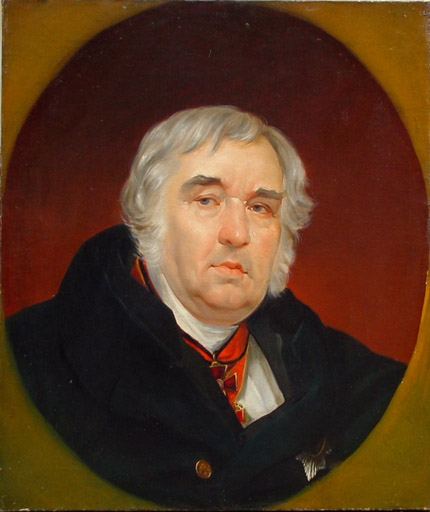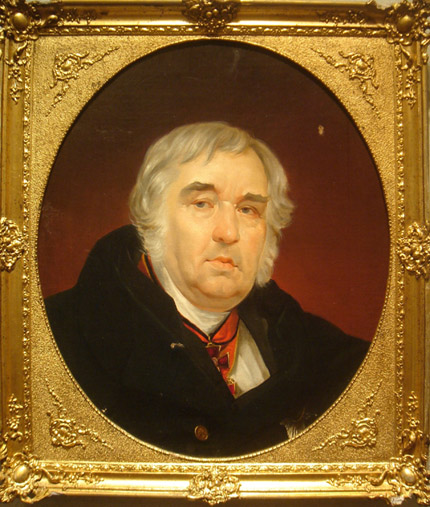 home
about
artists
exhibitions press
contact
purchase
home
about
artists
exhibitions press
contact
purchase |
|
|
The Sketch to the Portrait of Ivan A.
Krylov |
KARL BRYULLOV
(1799-1852) Karl Pavlovich Bryullov (12 December 1799 – 11 June 1852) was a Russian painter. He is regarded as a key figure in transition from the Russian neoclassicism to romanticism. Karl Bryullov (Brullo until 1822, when the family name was changed to a more Russian style) was born in 1799 in St. Petersburg into a family of Italian extraction. His great grand-father, grand-father, father and two elder brothers Fedor and Alexander were all painters. His father was a member of the Academy of Arts in St. Petersburg, which is where Karl and his brothers received their education. Karl entered the Academy in 1809. His talent and heritage told immediately and Bryullov advanced much faster than his fellow students. At the time, education in the academy was based on the principles of Classicism, and Bryullov's early works reflect this clearly. However, the political and social changes that the French Revolution and Napoleonic Wars had perpetrated in Europe were beginning to manifest themselves in fashions and artistic tastes. This was the beginning of the Romantic movement in both art and literature. In 1821, Bryullov graduated from the Academy with distinguish. During the short period when he worked independently in the years 1821-1823, it is easy to observe his rapid shift from Classicism to Romanticism. The artist focused primarily on the portrait, an branch of painting that was frowned upon in the Academy as low, but which was central to the Romantic idealisation of the human figure. Some of these works are the Portrait of the Secretary of State Piotr Kikin, Bryullov's patron, and his wife M.A. Kikina, and their daughter Maria Kikina, and the Portrait of the Actor A.N. Ramazanov. In 1822, Karl, along with his brother Alexander, was sent to Europe to study art there, as pensioners of the newly-created Society for the Promotion of Artists. True to his Classical education, Bryullov frowned upon anything that went against Classical ideals, expressing this disdain in letters that he wrote home. The two artists travelled through Germany, Austria, Venice and Florence, eventually arriving in Rome. Just like his Romantic contemporaries, Bryulov found the city irresistible. One of the requirements of the Society for the Promotion of Artists for its pensioners was to paint a large historical picture. In 1827, Bryullov visited the excavation site of Pompeii, a town destroyed and buried under a layer of ash during an eruption of the volcano Vesuvius on August 24, 79 A.D. Bryullov was greatly impressed when he saw the town, perfectly preserved under the ash. The cataclysm had been so sudden, that life had simply stopped, as if frozen in time. Six years would pass between the conception of the idea and its materialisation. After the first sketches had been done, Bryullov began studying the artifacts found in the excavations and historical documents, such as the letters of Pliny the Younger, who was an eye-witness of the event. It is believed that the young man persuading his mother to come with him in the right part of the picture is Pliny himself. The Last Day of Pompeii (1830-1833) was a huge success in Italy because of the way it blended Classical principles with Romantic ideals. It was also exhibited in the Louvre, Paris, but its reception there was lukewarm: in France, the transition stage between Classicism and Romanticism had been passed long since. When the painting arrived in St.Petersburg, it impressed the public profoundly, and made Bryullov's reputation as the foremost Russian painter of his day. Critics lavished the Last Day of Pompeii with praise, and Pushkin was inspired to write a poem on the subject. When Bryullov returned to Russia in 1835, the Academy of Arts organised a reception in his honour, and he was even granted an audience with Czar Nicholas I. In 1836, Bryullov was appointed a professor at the Academy. In the years that followed he painted mostly portraits. By the late 1840s, Bryullov's health was deteriorating due to his unrestrained lifestyle, unhappy marriage and his hard work on frescoes in St. Isaac's Cathedral in St. Petersburg, which he was unable to finish. In 1849, the painter went abroad, in the hopes that warmer climes would help his recovery. Bryullov visited Germany and England, went to Madeira, where he spent one year and his health seemed to genuinely improve, and his last two years in Rome. He created several excellent works during these years, including portraits of members of the Tittoni family, with whom he was very close. He died of a stroke in Rome on June 23, 1852. |
|
|
E-mail: info@hayhillgallery.com |

